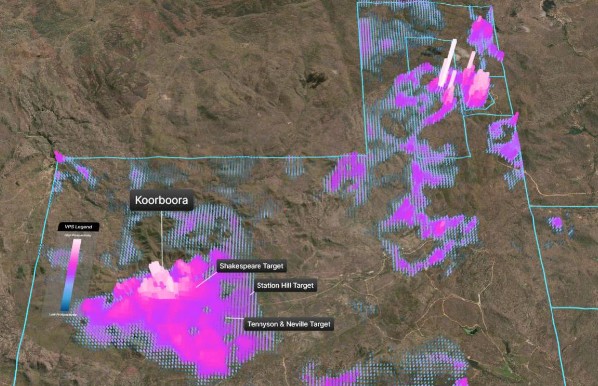Koorboora Project
Minerals
- Tin (Sn)
- Tungsten/Wolfram (W)
- Gold (Au)
- Silver (Ag)
- Copper (Cu)
- Zinc (Zn)
- Lead (Pb)
“With up to 7% Sn, Tennyson drilling confirms the theory of near surface low-grade high-volume deposit in tin bearing porphyry at Koorboora”.
(Pixie Hughes, BSc Joint Hons Geol/Geog MAIG)
Overview
The Koorboora mineral field, once Australia’s largest tungsten supplier, has a rich mining history dating back to the early 1900s, when it produced 20 tonnes of tungsten per month. This highly prospective area includes the Tennyson, Shakespeare, Two Jacks, and Neville mines.
Historical exploration
Historical reporting on the Koorboora mineral field provides useful information about exploration and mining production figures. These reports include CSR Ltd.’s extensive exploration program, which highlights numerous highly anomalous tin and gold assays. The program was abandoned when the tin price collapsed in 1984.
Value capture
John Nethery, a preeminent Chillagoe-based geologist with over 50 years of experience, collaborated with DCM to develop high priority 1,000m drilling targets for 2023. Drilling was completed in the second half of 2023, with excellent results indicating that additional exploration is justified at all four prospects. Some highlights of the 2023 drilling program are listed below.
- Tennyson (KB009)
Shallow drill results included: 1m @ 1710ppm Ag, 17.85% Pb, 9.88% Zn, 7.06% Sn at 19m.
From 17 to 30m a 13m interval @ 1.36ppm Ag and 0.5% Sn. - Two Jacks (KB001)
Shallow drill results included: 8m @ 0.38% Sn from 42m including 1m @ 0.76% Sn. - Neville (KB012)
Shallow drill results included: 11m @ 0.26% Sn, including 1m @ 1.88% Sn and 2m @ 1.54% W between 32 and 34m. - Shakespeare (KB007)
Shallow drill results included: 5m @ 0.12% Sn including 1m @ 0.32% Sn from 78m.
Subsequent exploration has significantly advanced the geological framework for the district. High- resolution soil geochemistry grids combined with drone magnetics have delineated multiple north- northwest trending geophysical anomalies spatially coincident with mapped structures and historical audits. These anomalies are interpreted as potential feeder zones or intrusive contacts, consistent with mineralisation controls seen at Two Jacks and Neville.
The integration of geophysics, geochemistry, and structural mapping has facilitated the development of a refined 3D geological model, now being used to rank and vector future drilling targets. Planning is underway for a Phase 2 drill campaign, incorporating deeper RC and diamond drilling across high-priority zones with coincident geophysical, geochemical, and structural indicators.
From a strategic standpoint, Koorboora offers the potential for:
- Discovery of a stand-alone polymetallic deposit, or
- Supplemental high-grade feed for a central processing hub at Dover Castle.
The area’s multi-metal character, combined with demonstrated mineral system fertility, reinforces the potential for scalable discovery. Moreover, the spatial distribution of targets and known structures supports the view that Koorboora represents a district-scale opportunity, not just a series of isolated anomalies.
VRIFY-driven 3D site visualisation is nearing completion with initial imagery reinforcing the enormous potential of the Koorboora Deposit (see below image).

AI Visualisation of Koorboora Resource Potential with Historic Mines
Koorboora underscores the broader thesis underpinning DCML’s regional exploration program: the Petford Mineral Field remains vastly underexplored with modern techniques, and the same structural corridors that control mineralisation at Dover Castle appear to extend through this adjacent terrain. Future success at Koorboora could materially enhance the company’s metal inventory and support the long-term vision of a multi-source, critical minerals development hub in North Queensland.

